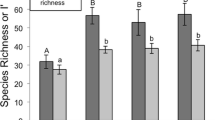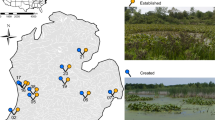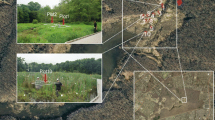Abstract
Recent research suggests that created wetlands do not look, or function, like the natural systems they are intended to replace. Proper planning, construction, and the introduction of appropriate biotic material should initiate natural processes which continue indefinitely in a successful wetland creation project, with minimal human input. To determine if differences existed between created and natural wetlands, we compared soil matrix chroma, organic matter content, rock fragment content, bulk density, particle size distribution, vegetation species richness, total plant cover, and average wetland indicator status in created (n = 12) and natural (n = 14)wetlands in Pennsylvania (USA). Created wetlands ranged in age from two to 18 years. Soils in created wetlands had less organic matter content, greater bulk densities, higher matrix chroma, and more rock fragments than reference wetlands. Soils in reference wetlands had clay loam textures with high silt content, while sandy clay loam textures predominated in the created sites. Vegetation species richness and total cover were both greater in natural reference wetlands. Vegetation in created wetlands included a greater proportion of upland species than found in the reference wetlands. There were significant differences in soils and vegetation characteristics between younger and older created wetlands, though we could not say older created sites were trending towards the reference wetland condition. Updated site selection practices, more careful consideration of monitoring period lengths, and, especially, a stronger effort to recreate wetland types native to the region should result in increased similarity between created and natural wetlands.
Similar content being viewed by others
References
Atkinson, R.B., Cairns, J., Jr, Perry, J.E. and Smith, E. 1993. Use of created wetland delineation and weighted averages as a component of assessment. Wetlands 13: 185–193.
Bishel, L. 1994. Soil Properties of Natural Reference Wetlands and Wetland Mitigation Projects in Pennsylvania. MS thesis, The Pennsylvania State University, University Park, PA, USA.
Bishel-Machung, L., Brooks, R.P., Yates, S.S. and Hoover, K.L. 1996. Soil properties of reference wetlands and wetland creation projects in Pennsylvania. Wetlands 16: 530–541.
Blake, G.R. and Hartge, K.H. 1986. Bulk density. In: Methods of Soil Analysis, Part 1. Physical and Mineralogical Methods. Soil Science Society of America, Madison, WI, USA.
Boutin, C. and Keddy, P.A. 1993. A functional classification of wetland plants. J. Veg. Sci. 4: 591–600.
Bouyoucos, G.J. 1962. Hydrometer method improved for making particle size analysis of soils. Agron. J. 54: 464–465.
Brinson, M.M. and Rheinhardt, R. 1996. The role of reference wet-lands in functional assessment and mitigation. Ecol. Appl. 6: 69–76.
Brooks, R.P. 1989. Monitoring wetlands. In: Majumdar, S.K., Brooks, R.P., Brenner, F.J. and Tiner, R.W., Jr. (eds.), Wet-lands Ecology and Conservation: Emphasis in Pennsylvania. pp. 289–298. The Pennsylvania Academy of Science, Easton, PA, USA.
Brooks, R.P. 1993. Restoration and creation of wetlands. In: Dennison, M.S. and Berry, J.F. (eds.), Wetlands: Guide to Science, Law, and Technology. pp. 319–351. Noyes Publications, Park Ridge, NJ, USA.
Brooks, R.P., Cole, C.A., Wardrop, D.H., Bishel-Machung, L., Prosser, D.J., Campbell, D.A. and Gaudette, M.T. 1996. Final report for the project: Evaluating and implementing watershed approaches for protecting Pennsylvania's wetlands – Volume II, Part A. Penn State Cooperative Wetlands Center, Environmental Resources Research Institute, The Pennsylvania State University, University Park, PA, USA.
Brown, L. 1979. An Identification Guide. Houghton Mifflin Co., New York, NY, USA.
Buol, S.W. 1990. Soil Genesis and Classification. Iowa State University Press, Ames, IA, USA.
Cole, C.A. 1998. Theoretical function or functional theory? Issues in wetland creation. In: McComb, A.J. and Davis, J.A. (eds.), Wetlands for the Future. pp. 679–690. Gleneagles Publishing, Adelaide, Australia.
Cole, C.A. 1999. Ecological theory and its role in the rehabilitation of wetlands. In: Streever, W.J. (ed.), International Perspectives in Wetland Rehabilitation. pp. 265–275. Kluwer Academic Publishers, The Netherlands.
Cole, C.A. and Brooks, R.P. 2000. A comparison of the hydrologic characteristics of natural and created mainstem floodplain wetlands in Pennsylvania. Ecol. Eng. 14: 221–231.
Cole, C.A., Brooks, R.P. and Wardrop, D.H. 1997. Wetland hydrology and water quality as a function of hydrogeomorphic subclass. Wetlands 17: 456–467.
Cole, C.A., Brooks, R.P. and Wardrop, D.H. 1998. Building a better wetland – A response to Linda Zug. Wetland J. 10: 8–11.
Cowardin, L.M., Carter, V., Golet, F.C. and LaRoe, F.C. 1979. Classification of Wetlands and Deep Water Habitats of the United States. U.S. Fish and Wildlife Service Pub., Washington, D.C. FWS/OBS-79/31.
Erwin, K.L. 1991. An Evaluation of Wetland Mitigation in the South Florida Water Management District, Volume I. Final Report to South Florida Water Management District, West Palm Beach, FL., USA.
Freeland, J.A. 1999. Hydric Soil Field Guide for the United States. Society of Wetland Scientists, Lawrence, KS, USA.
Galatowitsch, S.M. and van der Valk, A.E. 1994. Restoring Prairie Wetlands: An Ecological Approach. Iowa State University Press, Ames, IA, USA.
Holland, C.C. and Kentula, M.E. 1992. Impacts of Section 404 permits requiring compensatory mitigation on wetlands in California (USA). Wetl. Ecol. & Manag. 2: 157–169.
Hotchkiss, N. 1972. Common marsh, underwater, and floating-leaved plants of the United States and Canada. Dover Publ., Inc., New York, NY, USA.
Jarman, N.M., Dobberteen, R.A., Windmiller, B. and Lelito, P.R. 1991. Evaluation of created freshwater wetlands in Massachusetts. Rest. & Manag. Notes 9: 26–29.
Kentula, M.E., Brooks, R.P., Gwin, S.E., Holland, C.C., Sherman, A.D. and Sifneos, J.C. 1992. An approach to improving decision-making in wetland restoration and creation. In: Hairston, J.A. (ed.), U.S. Environmental Protection Agency, Environmental Research Lab, Corvallis, OR, USA.
Knobel, E. 1980. Field Guide to the Grasses, Sedges, and Rushes of the United States. Dover Publ., Inc., New York, NY, USA.
Mager, A. 1990. National Marine Fisheries Service Habitat Conservation Efforts Related to Federal Regulatory Programs in the Southeastern United States. NOAA Technical Memorandum NMFS-SEC-260.
Minitab, Inc. 1995. Minitab Release 10.5 Xtra. State College, PA, USA.
Mitsch, W.J. and Gosselink, J.G. 1993. Wetlands, 2nd edn. Van Nostrand Reinhold, New York, NY, USA.
Mitsch, W.J. and Wilson, R.F. 1996. Improving the success of wetland creation and restoration with know-how, time, and self-design. Ecol. Appl. 6: 77–83.
Newcomb, L. 1977. Wildflower Guide. Little, Brown, and Co., Inc., Boston, MA, USA.
Odum, E.P. 1969. The strategy of ecosystem development. Science 164: 262–270.
Race, M.S. 1985. Critique of present wetlands mitigation policies in the United States based on an analysis of past restoration projects in San Francisco Bay. Env. Manag. 9: 71–82.
Reinartz, J.A. and Warne, E.L. 1993. Development of vegetation in small created wetlands in southeastern Wisconsin. Wetlands 13: 153–164.
Reppert, R.R. 1992. Wetland Mitigation Banking Concepts. National wetland mitigation banking study. WR Report 92-WMB-1. U.S. Army Corps of Engineers, Water Resources Support Center, Institute for Water Resources. Alexandria, VA, USA.
Segelquist, C.A., Slauson, W.L., Scott, M.L. and Auble, G.T. 1990. Synthesis of soil-plant correspondence data from twelve wetland studies throughout the United States. U.S. Fish & Wildlife Serv., Biol. Rep. 90(19).
Streever, W.J., Portier, K.M. and Crisman, T. 1996. A comparison of dipterans from ten created and ten natural wetlands. Wetlands 16: 416–428.
Stauffer, A.L. and Brooks, R.P. 1997. Plant and soil responses to salvaged marsh surface and organic matter amendments at a created wetland in central Pennsylvania. Wetlands 17: 90–105.
Storer, D.A. 1984. A simple high sample volume ashing procedure for determination of soil organic matter content. Comm. Soil Sci. Plant Anal. 15: 759–772.
U.S. Army Corps of Engineers. 1987. Corps of Engineers Wet-lands Delineation Manual. Technical Report Y-87-1, Waterways Experiment Station, Vicksburg, MS. 100 pp.
Wentworth, T.G., Johnson, G.P. and Kologiski, R.L. 1988. Designation of wetlands by weighted averages of vegetation data: A preliminary evaluation. Water Res. Bull. 24: 389–396.
Author information
Authors and Affiliations
Rights and permissions
About this article
Cite this article
Campbell, D.A., Cole, C.A. & Brooks, R.P. A comparison of created and natural wetlands in Pennsylvania, USA. Wetlands Ecology and Management 10, 41–49 (2002). https://doi.org/10.1023/A:1014335618914
Issue Date:
DOI: https://doi.org/10.1023/A:1014335618914




